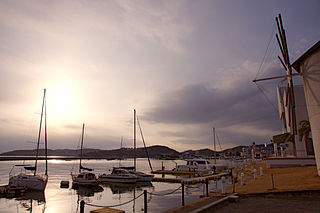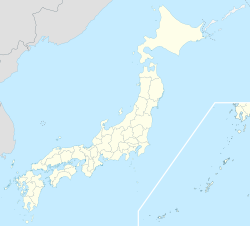
Kawaguchi is a city located in Saitama Prefecture, Japan. As of 1 January 2021, the city had an estimated population of 607,373 in 293,582 households and a population density of 9800 persons per km². The total area of the city is 61.95 square kilometres (23.92 sq mi). It is the Greater Tokyo Area's 8th most populated city, and second largest in Saitama Prefecture, after eponymous Saitama.

Gosen is a city located in Niigata Prefecture, Japan. As of 11 September 2024, the city had an estimated population of 45,916 in 19,086 households, and a population density of 138 persons per km². The total area of the city is 351.91 square kilometres (135.87 sq mi).

Suita is a city located in Osaka Prefecture, Japan. As of 31 March 2023, the city had an estimated population of 381,238 in 182636 households and a population density of 11,000 persons per km2. The total area of the city is 36.09 square kilometres (13.93 sq mi). It is a suburban city of Osaka City and a part of the Kyoto-Osaka-Kobe metropolitan area.

Ibara is a city located in Okayama Prefecture, Japan. As of 31 March 2023, the city had an estimated population of 37,835 in 16677 households and a population density of 160 persons per km2. The total area of the city is 243.54 square kilometres (94.03 sq mi).

Sōja is a city located in Okayama Prefecture, Japan. As of 31 March 2023, the city had an estimated population of 69,428 and a population density of 330 persons per km². The total area of the city is 211.90 square kilometres (81.82 sq mi).

Takahashi is a city located in Okayama Prefecture, Japan. As of 28 February 2023, the city had an estimated population of 27,538 in 13,678 households. and a population density of 50 persons per km2. The total area of the city is 546.99 square kilometres (211.19 sq mi). Bitchū Matsuyama Castle overlooks the town. Another significant location is Raikyū-ji, a Buddhist temple with a historic garden.

Niimi is a city located in northwestern Okayama Prefecture, Japan. As of 28 February 2023, the city had an estimated population of 27,106 in 12626 households. and a population density of 34 persons per km2. The total area of the city is 793.29 square kilometres (306.29 sq mi)

Shōbara is a city in Hiroshima Prefecture, Japan. As of 31 March 2023, the city had an estimated population of 32,343 in 14984 households and a population density of 26 persons per km². The total area of the city is 1,246.49 square kilometres (481.27 sq mi).

Hayashima is a town located in Tsukubo District, Okayama Prefecture, Japan. As of 1 February 2024, the town had an estimated population of 12,772 in 5261 households and a population density of 1700 persons per km2. The total area of the town is 7.62 square kilometres (2.94 sq mi), making it the smallest municipality in Okayama in terms of area, but also the most densely populated.

Satoshō is a town located in Asakuchi District, Okayama Prefecture, Japan. As of 1 March 2023, the town had an estimated population of 11,026 in 4636 households and a population density of 900 persons per km2. The total area of the town is 12.23 square kilometres (4.72 sq mi).

Yakage is a town located in Oda District, Okayama Prefecture, Japan. As of 1 March 2023, the town had an estimated population of 13,418 in 5445 households and a population density of 150 persons per km². The total area of the town is 90.62 square kilometres (34.99 sq mi).
Jōbō was a district located in Okayama Prefecture, Japan.

Kagamino is a town located in Tomata District, Okayama Prefecture, Japan. As of 31 January 2023, the town had an estimated population of 12,425 in 5633 households and a population density of 30 persons per km2. The total area of the town is 419.68 square kilometres (162.04 sq mi).

Setouchi is a city located in southern Okayama Prefecture, Japan. As of 31 January 2023, the city had an estimated population of 36,499 in 15,934 households and a population density of 290 persons per km². The total area of the city is 125.45 square kilometres (48.44 sq mi).

Jinsekikōgen is a town located in Jinseki District, Hiroshima Prefecture, Japan. As of 1 April 2023, the town had an estimated population of 8,166 in 3781 households, and a population density of 21 persons per km2 in 7,269 households. The total area of the town is 381.98 km2 (147.48 sq mi).

Okayama is the capital city of Okayama Prefecture in the Chūgoku region of Japan. The Okayama metropolitan area, centered around the city, has the largest urban employment zone in the Chugoku region of western Japan. The city was founded on June 1, 1889. As of February 2023, the city has an estimated population of 700,940 and a population density of 890 people per km2. The total area is 789.95 square kilometres.

Asakuchi is a city located in Okayama Prefecture, Japan. As of 1 March 2023, the city had an estimated population of 33,322 in 14,409 households and a population density of 500 persons per km2. The total area of the city is 66.464 square kilometres (25.662 sq mi). The headquarters of the Konkokyo religion is in Asakuchi.

Misaki is a town located in Kume District, Okayama Prefecture, Japan. As of 31 December 2022, the town had an estimated population of 13,060 in 5867 households and a population density of 56 persons per km2. The total area of the town is 232.17 square kilometres (89.64 sq mi).

Kurashiki is a city located in Okayama Prefecture, Japan. As of 31 March 2023, the city had an estimated population of 478,651 and a population density of 1300 persons per km2. The total area of the city is 355.63 square kilometres (137.31 sq mi).























